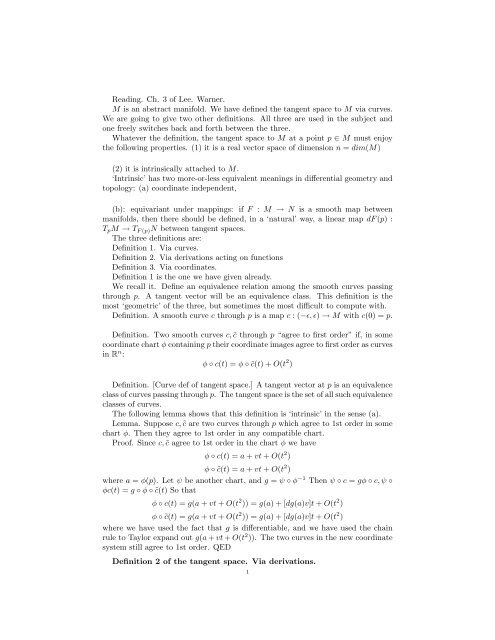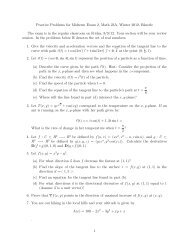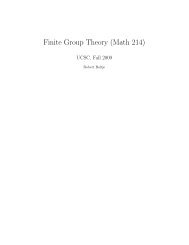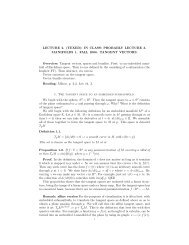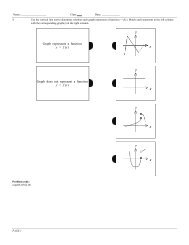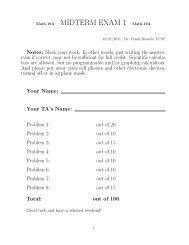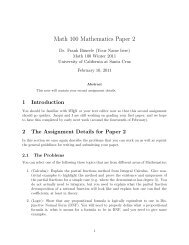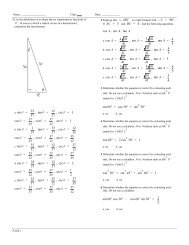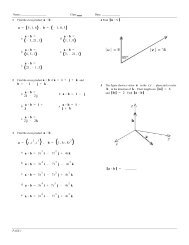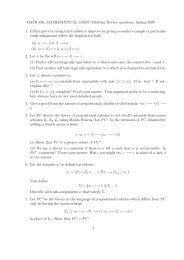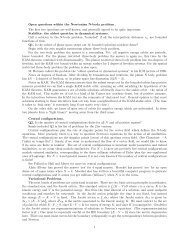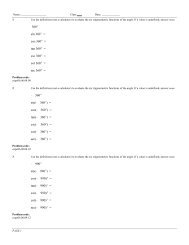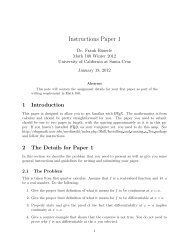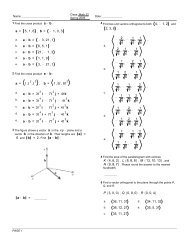Lecture Notes 3: the three defs of the tangent space
Lecture Notes 3: the three defs of the tangent space
Lecture Notes 3: the three defs of the tangent space
Create successful ePaper yourself
Turn your PDF publications into a flip-book with our unique Google optimized e-Paper software.
Reading. Ch. 3 <strong>of</strong> Lee. Warner.<br />
M is an abstract manifold. We have defined <strong>the</strong> <strong>tangent</strong> <strong>space</strong> to M via curves.<br />
We are going to give two o<strong>the</strong>r definitions. All <strong>three</strong> are used in <strong>the</strong> subject and<br />
one freely switches back and forth between <strong>the</strong> <strong>three</strong>.<br />
Whatever <strong>the</strong> definition, <strong>the</strong> <strong>tangent</strong> <strong>space</strong> to M at a point p ∈ M must enjoy<br />
<strong>the</strong> following properties. (1) it is a real vector <strong>space</strong> <strong>of</strong> dimension n = dim(M)<br />
(2) it is intrinsically attached to M.<br />
‘Intrinsic’ has two more-or-less equivalent meanings in differential geometry and<br />
topology: (a) coordinate independent,<br />
(b): equivariant under mappings: if F : M → N is a smooth map between<br />
manifolds, <strong>the</strong>n <strong>the</strong>re should be defined, in a ‘natural’ way, a linear map dF (p) :<br />
T p M → T F (p) N between <strong>tangent</strong> <strong>space</strong>s.<br />
The <strong>three</strong> definitions are:<br />
Definition 1. Via curves.<br />
Definition 2. Via derivations acting on functions<br />
Definition 3. Via coordinates.<br />
Definition 1 is <strong>the</strong> one we have given already.<br />
We recall it. Define an equivalence relation among <strong>the</strong> smooth curves passing<br />
through p. A <strong>tangent</strong> vector will be an equivalence class. This definition is <strong>the</strong><br />
most ‘geometric’ <strong>of</strong> <strong>the</strong> <strong>three</strong>, but sometimes <strong>the</strong> most difficult to compute with.<br />
Definition. A smooth curve c through p is a map c : (−ɛ, ɛ) → M with c(0) = p.<br />
Definition. Two smooth curves c, ˜c through p “agree to first order” if, in some<br />
coordinate chart φ containing p <strong>the</strong>ir coordinate images agree to first order as curves<br />
in R n :<br />
φ ◦ c(t) = φ ◦ ˜c(t) + O(t 2 )<br />
Definition. [Curve def <strong>of</strong> <strong>tangent</strong> <strong>space</strong>.] A <strong>tangent</strong> vector at p is an equivalence<br />
class <strong>of</strong> curves passing through p. The <strong>tangent</strong> <strong>space</strong> is <strong>the</strong> set <strong>of</strong> all such equivalence<br />
classes <strong>of</strong> curves.<br />
The following lemma shows that this definition is ‘intrinsic’ in <strong>the</strong> sense (a).<br />
Lemma. Suppose c, ˜c are two curves through p which agree to 1st order in some<br />
chart φ. Then <strong>the</strong>y agree to 1st order in any compatible chart.<br />
Pro<strong>of</strong>. Since c, ˜c agree to 1st order in <strong>the</strong> chart φ we have<br />
φ ◦ c(t) = a + vt + O(t 2 )<br />
φ ◦ ˜c(t) = a + vt + O(t 2 )<br />
where a = φ(p). Let ψ be ano<strong>the</strong>r chart, and g = ψ ◦ φ −1 Then ψ ◦ c = gφ ◦ c, ψ ◦<br />
φc(t) = g ◦ φ ◦ ˜c(t) So that<br />
φ ◦ c(t) = g(a + vt + O(t 2 )) = g(a) + [dg(a)v]t + O(t 2 )<br />
φ ◦ ˜c(t) = g(a + vt + O(t 2 )) = g(a) + [dg(a)v]t + O(t 2 )<br />
where we have used <strong>the</strong> fact that g is differentiable, and we have used <strong>the</strong> chain<br />
rule to Taylor expand out g(a + vt + O(t 2 )). The two curves in <strong>the</strong> new coordinate<br />
system still agree to 1st order. QED<br />
Definition 2 <strong>of</strong> <strong>the</strong> <strong>tangent</strong> <strong>space</strong>. Via derivations.<br />
1
2<br />
Write C ∞ (M) for <strong>the</strong> <strong>space</strong> <strong>of</strong> all smooth functions on M. It is forms a commutative<br />
algebra over <strong>the</strong> reals. We can add, and multiply functions, and scalar<br />
multiply <strong>the</strong>m.<br />
Definiton. A derivation at p is an R linear map C ∞ (M) → R which is a derivation<br />
in Leibnitz’s sense:<br />
v[fg] = f(p)v[g] + g(p)v[f]<br />
In o<strong>the</strong>r words: it is a linear functional for which <strong>the</strong> product rule works.<br />
Definition. The <strong>tangent</strong> <strong>space</strong> to M at p is <strong>the</strong> <strong>space</strong> <strong>of</strong> derivations at p.<br />
That this definiton is intrinsic is clear. We did not use coordinates to define it.<br />
It is also obviously a vector <strong>space</strong>, since we can add derivations and multiply <strong>the</strong>m<br />
by real numbers. But <strong>the</strong> dimension <strong>of</strong> this vector <strong>space</strong> is not obvious. Is it finite?<br />
Maybe <strong>the</strong>re are too many functions? Or is it zero? How do we know a manifold<br />
has ANY globally defined functions?<br />
Exercise. If f and g agree in a nbhd <strong>of</strong> p and v is a derivation at p, <strong>the</strong>n<br />
v[f] = v[g].<br />
Prop. If f is smooth defined in a coord nbhd <strong>of</strong> p, <strong>the</strong>n it can be smoothly<br />
extended to all <strong>of</strong> M.<br />
Pf. Bump functions.<br />
Cor. The value <strong>of</strong> v[f] is well-defined when f is defined on a nbhd <strong>of</strong> p, ra<strong>the</strong>r<br />
than all <strong>of</strong> M.<br />
( Rmk. Smooth Urysohn lemma. )<br />
Cor. to exercise. Let U be any nbhod <strong>of</strong> p and consider <strong>the</strong> <strong>space</strong> C ∞ (U) <strong>of</strong><br />
smooth functions on To answer this last question will lead us to bump functions,<br />
an important tool later on.<br />
Definition 3 <strong>of</strong> <strong>the</strong> <strong>tangent</strong> <strong>space</strong>. via coordinates.<br />
Consider all charts ψ α : U α ⊂ M → R n containing p, so that p ∈ U α . For each<br />
such chart introduce a copy <strong>of</strong> R n , denoted by R n α, and form <strong>the</strong> disjoint union <strong>of</strong><br />
all <strong>the</strong>se vector <strong>space</strong>s. :<br />
∐<br />
{α:p∈U α}<br />
. The funny symbol ∐ indicates DISJOINT union. Define an equivalence relation<br />
∼ on this disjoint union by declaring v α ∈ R n α, and v β ∈ R n β<br />
to be equivalent:<br />
v α ∼ v β : iff d(ψ β ◦ ψα −1 )(ψ α (p))v α = v β . Then define T p M = ∐ {α:p∈U α} Rn α/ ∼.<br />
This definition is clearly intrinsic according to notion (a) <strong>of</strong> ‘intrinsic’, since we<br />
have divided out by all choice <strong>of</strong> charts. It is also clearly a vector <strong>space</strong> <strong>of</strong> dimension<br />
n. Fix any one chart ψ α : U α ⊂ M− → R n . Then every [v] ∈ T p M has a unique<br />
representative v α ∈ R n α so that R N ∼ α = T p M.<br />
Pros and cons. This is <strong>the</strong> definition closest to <strong>the</strong> way computations are done.<br />
It is <strong>the</strong> ugliest definition.<br />
Bases in <strong>the</strong> various definitions. Standard notation. Equivalences between defintions.<br />
Let x i be coordinates defined in a nbhd <strong>of</strong> p. Thus, some coordinate chart ψ :<br />
U ⊂ M → R n is written out as ψ(q) = (x 1 (q), . . . , x n (q)). In all <strong>three</strong> definitions,<br />
∂<br />
<strong>the</strong>se coordinates define a basis<br />
∂x<br />
, i = 1, . . . , n for T i p M. Thus a typical element<br />
<strong>of</strong> T p M can be uniquely expressed as Σv i ∂<br />
∂x<br />
with v i ∈ R.<br />
i<br />
R n α
3<br />
Basis in definition 1. Consider <strong>the</strong> coordinate x i -curve γ i . By this we mean<br />
<strong>the</strong> curve in R n parallel to <strong>the</strong> x i axis and through <strong>the</strong> point corresponding to p:<br />
thus:γ i (t) is defined by x j (t) = x j 0 , xi (t) = x i 0 + t, where x i 0 are <strong>the</strong> coordinates <strong>of</strong><br />
p. Then ∂<br />
∂x<br />
means <strong>the</strong> equivalence class <strong>of</strong> <strong>the</strong> curve ψ −1 (γ i i ).<br />
Basis in definiton 2. If f ∈ C ∞ (M) <strong>the</strong>n f ◦ ψ −1 : R n → R can be written (by a<br />
slight abuse <strong>of</strong> notation) as f(x 1 , . . . , x n ). The derivation<br />
∂<br />
∂x<br />
is <strong>the</strong> usual partial<br />
i<br />
∂<br />
derivative:<br />
∂x<br />
[f] = ∂f<br />
i ∂x i<br />
∂<br />
Basis in definition 3.<br />
∂x<br />
is <strong>the</strong> vector whose representative in <strong>the</strong> chart for<br />
i<br />
ψ = ψ α , is <strong>the</strong> vector e i = (0, . . . 0, 1, 0, . . .) ∈ R n α.<br />
Equivalences <strong>of</strong> definitons.<br />
Def 1 to 2. To define a derivation v from a curve c we set v[f] = ( d dt | t=0(f(c(t)).<br />
Note: R−→M c<br />
−→R<br />
f<br />
Coordinate computations shows c ↦→ v is well-defined on <strong>the</strong> level <strong>of</strong> equivalence<br />
classes: if c 1 ∼ c 2 <strong>the</strong>n ( d dt | t=0(f(c 1 (t)) = ( d dt | t=0(f(c 1 (t)). A coordinate computation<br />
also shows that <strong>the</strong> map c ′ (0) → v is linear. If v = Σv i ∂<br />
∂x<br />
we compute, using<br />
i<br />
<strong>the</strong> chain rule that indeed:<br />
v[f] = Σv i ∂<br />
∂x i [f]<br />
as it should.<br />
Definition 2 corresponds to <strong>the</strong> directional derivative <strong>of</strong> vector calculus.<br />
Def 1 to Def 3. We went from 1 to 3 when we showed that <strong>the</strong> equivalence class<br />
<strong>of</strong> def 1 was chart-independent. (The lemma following <strong>the</strong> explanation <strong>of</strong> def 1:<br />
write <strong>the</strong> curve in a coord chart. Its first order derivative is <strong>the</strong> <strong>tangent</strong> vector as<br />
represented in that chart. ) Conversely, given a chart φ α : U α → R n = R n α with<br />
P 0 corresponding to p, <strong>the</strong> inverse image under φ α <strong>of</strong> <strong>the</strong> curve P 0 + tv ∈ R n α is <strong>the</strong><br />
curve whose equivalence class represents v.<br />
Def 3 to 2. The vector v = (v 1 , . . . v n ) ∈ R n α represents <strong>the</strong> derivation Σv i ∂<br />
1.<br />
More on Def 2. Why is <strong>the</strong> <strong>space</strong> <strong>of</strong> derivations based at p spanned by <strong>the</strong><br />
It is not even clear that this <strong>space</strong> <strong>of</strong> derivations is finite-dimensional.<br />
∂x i .<br />
∂<br />
∂x i ?<br />
Define bump functions. Discuss bump fns. Extending fns. Why we can think <strong>of</strong><br />
x i as fns on all <strong>of</strong> M.<br />
Impossibility for cx mfds.<br />
2. Derivations. Maximal ideals. Co<strong>tangent</strong> <strong>space</strong>.<br />
We state some algebraic consequences <strong>of</strong> <strong>the</strong> definition. Let v be a derivation at<br />
p, and let m p ⊂ C ∞ (M) be <strong>the</strong> subalgebra <strong>of</strong> functions vanishing at p.<br />
Fact 1. v[c] = 0, c a constant function.<br />
Pro<strong>of</strong>: 1 = 1 · 1, so v[1] = 1v[1] + 1v[1] = 2v[1], implying that v[1] = 0. Now<br />
v[c] = cv[1].<br />
Consequence. v[f] = v[f − f(p)].<br />
3.<br />
Fact 2. If h = m 2 p <strong>the</strong>n v[h] = 0.<br />
Pro<strong>of</strong> h ∈ m 2 p means h = fg for some f, g ∈ m p . Then v[h] = f(p)v[g]+g(p)v[f] =<br />
0 + 0 since f(p) = g(p) = 0.
4<br />
Proposition 0.1. v defines a linear map m p /m 2 p → R and is uniquely determined<br />
by this map.<br />
Pro<strong>of</strong>: By fact 1 <strong>the</strong> value <strong>of</strong> v is determined by its values on m p . Any linear<br />
map L : E → F between vector <strong>space</strong>s descends canonically to a ‘quotient map”<br />
E/ker(L) → F , and, if we know ker(L), <strong>the</strong>n L is uniquely determined by this<br />
quotient map.<br />
3.<br />
Fact 3. m p /m 2 p is a finite-dimensional vector <strong>space</strong> <strong>of</strong> dimension n.<br />
Pro<strong>of</strong> <strong>of</strong> Fact 3. The n coordinates are <strong>the</strong> 1st order Taylor expansion <strong>of</strong> a<br />
function. In detail, use coordinates x i , i = 1, . . . , n centered at p. NOTE: “Centered<br />
at p” means that x i (p) = 0.) Then Fact 2 transfers to <strong>the</strong> same statement regarding<br />
m 0 ⊂ C ∞ (R n ). Expand f in terms <strong>of</strong> <strong>the</strong> x i : f = Σa i x i + O(|x| 2 ). We must show<br />
that <strong>the</strong> remainder term O(|x| 2 ) is in m p . This is easily seen from<br />
Lemma 0.2 (Hadamard’s lemma. ). Let f be a smooth function vanishing at<br />
0 ∈ R n . Then we can write f = Σx i g i (x 1 , . . . , x n ) where <strong>the</strong> g i are smooth functions<br />
satisfying g(0) = ∂f<br />
∂x<br />
| i 0<br />
Pro<strong>of</strong> <strong>of</strong> Hadamard. Write f(x) = f(0) + ∫ d<br />
dt<br />
out <strong>the</strong> integral to obtain f(x) = Σx i g i (x) where g i (x) = ∫ 1<br />
f(tx)dt Use f(0) = 0 and expand<br />
∂f<br />
∂x<br />
(tx)dt. QED (also<br />
i<br />
see, Lee, appendix).<br />
End <strong>of</strong> pro<strong>of</strong> <strong>of</strong> Fact 3. Hadamard’s lemma asserts that by subtracting <strong>of</strong>f <strong>the</strong><br />
linear Taylor expansion, Σa i x i from f we obtain a function in m 2 0.<br />
Definition. m p /m 2 p is called <strong>the</strong> “<strong>space</strong> <strong>of</strong> covectors” at p or <strong>the</strong> co<strong>tangent</strong> bundle<br />
at p and is denoted by T ∗ p M.<br />
Then <strong>the</strong> proposition asserts that <strong>the</strong> <strong>tangent</strong> <strong>space</strong> T p M (viewed as derivations)<br />
is canonically dual to T ∗ p M.<br />
Discussion.<br />
There is a long tradition <strong>of</strong> recovering and better understanding a manifold,<br />
variety, topological <strong>space</strong>,... by way <strong>of</strong> algebras <strong>of</strong> functiosn on it.<br />
<strong>the</strong> correspondence p ↦→ m p ⊂ C ∞ (M) embeds M as a family <strong>of</strong> maximal ideals<br />
within C ∞ (M).<br />
Perhaps <strong>the</strong> most striking is in <strong>the</strong> subject <strong>of</strong> C ∗ -algebras , <strong>the</strong> <strong>the</strong>orem called<br />
<strong>the</strong> Gelfand-Naimark <strong>the</strong>orem. Let M be a compact Hausdorff <strong>space</strong> and A <strong>the</strong><br />
<strong>space</strong> C 0 (M, C) <strong>of</strong> continous complex-valued functions on M, It is a commutative<br />
algebra over C. The sup norm, and <strong>the</strong> operation f ↦→ ¯f , gives A <strong>the</strong> structure <strong>of</strong><br />
what is known as a C ∗ -algebra.<br />
Gelfand-Naimark Theorem. Every commutative C ∗ algebra is C 0 (M, C) for some<br />
compact Hausdorff <strong>space</strong> M.<br />
The <strong>space</strong> M in <strong>the</strong> Gelfand-Naimark <strong>the</strong>orem is built out <strong>of</strong> “multiplicative<br />
linear functionals” and forms <strong>the</strong> “spectrum” <strong>of</strong> A. Conversely, given M, <strong>the</strong> associated<br />
“multiplicative linear functional” is evaluation at p: f ↦→ f(p), a map from<br />
A → C. The kernel <strong>of</strong> this map corresponds to our m p .<br />
Algebraic geometry. The subject begins by studying <strong>the</strong> zero locuses <strong>of</strong> polynomial<br />
functions. These zero locuses are called “varieties”. Varieties are very <strong>of</strong>ten<br />
manifolds, and are always manifolds at most <strong>of</strong> <strong>the</strong>ir points – like our cone or cross.<br />
An essential <strong>the</strong>me in algebraic geometry is <strong>the</strong> traffic back and forth between <strong>the</strong><br />
variety and <strong>the</strong> algebra <strong>of</strong> polynomial functions defined on <strong>the</strong> variety. The variety<br />
0
5<br />
is reconstructed out <strong>of</strong> <strong>the</strong> algebra, as <strong>the</strong> <strong>space</strong> <strong>of</strong> maximal ideals in <strong>the</strong> algebra.<br />
Our definition <strong>of</strong> <strong>the</strong> co<strong>tangent</strong> <strong>space</strong> and <strong>tangent</strong> <strong>space</strong> work in <strong>the</strong> algebraic setting,<br />
even over arbitrary rings (!) and are called <strong>the</strong> Zariski (co)<strong>tangent</strong> <strong>space</strong>.


